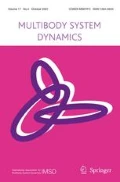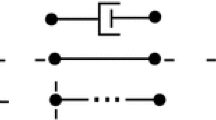Abstract
Coordinate singularities and gimbal lock are two phenomena that present themselves in models for the dynamics of mechanical systems. The former phenomenon pertains to the coordinates used to parameterize the configuration manifold of the system, while the latter phenomenon has a distinctive physical manifestation. In the present paper, we use tools from differential geometry to show how gimbal lock is intimately associated with an orthogonality condition on the applied forces and moments which act on the system. This condition is equivalent to a generalized applied force being normal to the configuration manifold of the system. Numerous examples, including the classic bead on a rotating hoop example and a gimbaled rigid body, are used to illuminate the orthogonality condition. These examples help to offer a new explanation for the elimination of gimbal lock by the addition of gimbals and demonstrate how integrable constraints alter the configuration manifold and may consequently eliminate coordinate singularities.









Similar content being viewed by others
Notes
Additional background for a variety of sources on rotation tensors, Euler angles, Euler bases, and dual Euler bases are collected in Appendix.
In other words, the generalized constraint forces do no virtual work in any motion of the system compatible with the constraints.
For representations of rotations with constant angular velocities on the real projective 2-space \(\mathbb{R}P^{2}\), the reader is referred to [20].
A discussion of the constraint forces and moments acting on the bodies shown in this figure can be found in [24].
References
Arnold, R.N., Maunder, L.: Gyrodynamics and Its Engineering Applications. Academic Press, New York (1961)
Baruh, H.: Analytical Dynamics. WCB/McGraw–Hill, Boston (1999)
Bohigas, O., Manubens, M., Ros, L.: Singularity-free path planning. In: Singularities of Robot Mechanisms, pp. 111–136. Springer, Berlin (2017)
Casey, J.: Geometrical derivation of Lagrange’s equations for a system of particles. Am. J. Phys. 62(9), 836–847 (1994)
Casey, J.: On the advantages of a geometrical viewpoint in the derivation of Lagrange’s equations for a rigid continuum. In: Casey, J., Crochet, M.J. (eds.) Theoretical, Experimental, and Numerical Contributions to the Mechanics of Fluids and Solids: A Collection of Papers in Honor of Paul M. Naghdi, pp. 805–847. Birkhäuser, Basel (1995). https://doi.org/10.1007/978-3-0348-9229-2_41
Casey, J.: On the representation of rigid body rotational dynamics in Hertzian configuration space. Int. J. Eng. Sci. 49(12), 1388–1396 (2011). https://doi.org/10.1016/j.ijengsci.2011.03.012
Casey, J., O’Reilly, O.M.: Geometrical derivation of Lagrange’s equations for a system of rigid bodies. Math. Mech. Solids 11(4), 401–422 (2006). https://doi.org/10.1177/1081286505044137
Fernandez, M., Macomber, G.R.: Inertial Guidance Engineering. Prentice Hall, Englewood Cliffs (1962)
Ganovelli, F., Corsini, M., Pattanaik, S., Di Benedetto, M.: Introduction to Computer Graphics: A Practical Learning Approach. CRC Press, Boca Raton (2015)
Greenwood, D.T.: Principles of Dynamics. Prentice Hall, Englewood Cliffs (1988)
Greenwood, D.T.: Advanced Dynamics. Cambridge University Press, Cambridge (2006)
Guha, S.: Computer Graphics Through OpenGL: From Theory to Experiments. CRC Press, Boca Raton (2015)
Hanson, A.J.: Visualizing quaternions. In: ACM SIGGRAPH 2005 Courses, p. 1. ACM, New York (2005)
Kane, T.R., Likins, P.W., Levinson, D.A.: Spacecraft Dynamics. McGraw–Hill, New York (1983), 445 p.
Machover, C.: Basics of Gyroscopes, vol. 1. JF Rider, New York (1960)
Marsden, J.E., Ratiu, T.: Introduction to Mechanics and Symmetry: A Basic Exposition of Classical Mechanical Systems, vol. 17. Springer, Berlin (2013)
McConnell, A.J.: Applications of the Absolute Differential Calculus. Blackie, London (1947). Corrected reprinted edition
Mebius, J.E., Kasperink, H.R., Kooijman, M.D.: Mathematics for simulation of near-vertical aircraft attitudes. In: Making It Real: Proceedings CEAS Symposium on Simulation Technology, Confederation of European Aerospace Societies, Delft, The Netherlands pp. 1–11 (1995). Paper Number MOD04
Moore, R.L., Thomason, H.E.: Gimbal geometry and attitude sensing of the ST-124 stabilized platform. Technical Report No. 19620002325 (1962)
Novelia, A., O’Reilly, O.M.: On geodesics of the rotation group SO(3). Regul. Chaotic Dyn. 20(6), 729–738 (2015). https://doi.org/10.1134/S1560354715060088
O’Donnell, C.F.: Inertial Navigation: Analysis and Design. McGraw–Hill, New York (1964)
O’Reilly, O.M.: The dual Euler basis: constraints, potentials, and Lagrange’s equations in rigid body dynamics. ASME J. Appl. Mech. 74(2), 256–258 (2007). https://doi.org/10.1115/1.2190231
O’Reilly, O.M.: Intermediate Dynamics for Engineers: A Unified Treatment of Newton–Euler and Lagrangian Mechanics. Cambridge University Press, New York (2008)
O’Reilly, O.M., Srinivasa, A.R.: A simple treatment of constraint forces and constraint moments in the dynamics of rigid bodies. ASME Appl. Mech. Rev. 67(1), 014,801 (2014). https://doi.org/10.1115/1.4028099
Shoemake, K.: Animating rotation with quaternion curves. ACM SIGGRAPH Comput. Graph. 19(3), 245–254 (1985)
Shuster, M.D., Oh, S.: Three-axis attitude determination from vector observations. J. Guid. Control Dyn. (2012)
Stuelpnagel, J.: On the parametrization of the three-dimensional rotation group. SIAM Rev. 6(4), 422–430 (1964)
Synge, J.L., Schild, A.: Tensor Calculus. University of Toronto Press, Toronto (1949)
Thomason, H.E.: A general description of the ST124-M intertial platform system. Tech. rep., George C. Marshall Space Flight Center, Huntsville, Alabama, Washington, DC (1965). Technical Report No. 19650024833
Thomson, W.T.: Introduction to Space Dynamics. Dover, New York (1986)
Acknowledgements
The work of Evan Hemingway was supported by a Berkeley Fellowship from the University of California at Berkeley and a U.S. National Science Foundation Graduate Research Fellowship. The authors are grateful to Professor James Casey for his helpful comments on an earlier draft of this paper.
Author information
Authors and Affiliations
Corresponding author
Appendix: Background on rotations
Appendix: Background on rotations
An example of a 3-dimensional configuration manifold results from the constrained motion of a rigid body rotating about a fixed point, such as in the motion of the Lagrange top. In this case, the rotation tensor \(\mathbf{Q}\) of the top belongs to the proper-orthogonal subgroup of linear second-order tensors, a 3-dimensional manifold called \(\mathsf{Orth}^{+}\) embedded in \(\mathcal{C}^{9}\). This subgroup is isomorphic to \(\mathit{SO}(3)\), the special orthogonal group of \(3 \times 3\) matrices. Furthermore, \(\mathit{SO}(3)\) is diffeomorphic to \(\mathbb{R}P^{3}\), real projective 3-space, and we can associate the configuration of the top to a point in \(\mathbb{R}P^{3}\).Footnote 4
Given an angle \(\theta \) and axis of rotation \(\mathbf{p}\), Euler’s formula for the rotation tensor is
where \(\text{skwt} ( \mathbf{p} ) \) indicates the skew tensor of \(\mathbf{p}\), which is given by the mapping
where \(\boldsymbol {\epsilon }\) is the third-order alternator tensor. Since \(\mathbf{Q}\) is proper orthogonal, it satisfies \(\mathbf{Q} {\mathbf{Q}} ^{T} = \mathbf{I}\) and \(\det {\mathbf{Q}} = + 1\). A skew-symmetric angular velocity tensor may therefore be defined using \(\mathbf{Q}\) as \(\boldsymbol {\Omega }= \dot{\mathbf{Q}} {\mathbf{Q}}^{T}\). We denote the space of skew-symmetric tensors as \(\mathsf{Skw}\). The angular velocity vector \(\boldsymbol {\upomega }\) is the axial vector of \(\boldsymbol {\Omega }\) which is given by the mapping
Thus, there exists an isomorphism between \(\mathsf{Skw}\) and \(\mathbb{E}^{3}\) through the maps \(\text{ax} ( \cdot ) \) and \(\text{skwt} ( \cdot ) \) for which the following is true:
for any \(\mathbf{a} \in \mathbb{E}^{3}\). Euler angles are a common choice of parametrization for \(\mathbf{Q}\). A general Euler angle decomposition is given by
where \(\{ \nu ^{1}, \nu ^{2}, \nu ^{3} \} \) are the Euler angles and \(\{ \mathbf{g}_{1}, \mathbf{g}_{2}, \mathbf{g}_{3} \} \) are the corresponding axes of rotation, which are collectively known as the Euler basis [22–24]. It is also convenient to define a reciprocal basis \(\{ \mathbf{g}^{i} \} \) known as the dual Euler basis with the property
where \(\delta _{i}^{j}\) is the Kronecker delta. A corotational (or body-fixed) basis is defined as the set \(\{ \mathbf{e}_{i} \} \) for which \(\mathbf{e}_{i} = \mathbf{Q} {\mathbf{E}}_{i}\) for \(i =1,2,3\). The rotation tensor has the same components in the corotational basis as it does in the inertial basis: \(\mathbf{Q} = Q _{ij} {\mathbf{e}}_{i} \otimes {\mathbf{e}}_{j} = Q_{ij} {\mathbf{E}} _{i} \otimes {\mathbf{E}}_{j}\). Using the abbreviations \(\cos ( \nu ) = \text{c} \nu \) and \(\sin ( \nu ) = \text{s} \nu \), a 3–2–1 Euler angle set yields the following parametrization:
where \(\nu ^{1} \in [0, 2\pi )\), \(\nu ^{2} \in [ -\frac{\pi }{2}, \frac{\pi }{2} ] \), and \(\nu ^{3} \in [0, 2\pi )\). A 3–1–3 Euler angle set yields the following parametrization:
where \(\nu ^{1} \in [0,2\pi )\), \(\nu ^{2} \in [ 0, \pi ] \), and \(\nu ^{3} \in [0, 2\pi )\).
For a given Euler angle parametrization, the following identity may be shown to hold:
where \(\mathbf{Q}\) is given by (A.5).
1.1 A.1 Constraining one of the Euler angles
An interesting situation occurs when the first or third Euler angle is constrained and the configuration manifold for the rotational motion of the rigid body becomes a two-torus \(T^{2}\) provided \(\nu ^{2}\) is extended to \(\nu _{e}^{2} \in [0, 2\pi )\). The latter case arises in the motion of the rigid bodies shown in Fig. 2.Footnote 5 If a set of 3–1–3 Euler angles are used to parameterize the rotation tensor \(\mathbf{Q}\) of these bodies, then the third angle \(\nu ^{3} = 0\). To use two angles to parameterize the rotation \(\mathbf{Q}\) of the constrained rigid bodies shown in Fig. 2, it is necessary that
In contrast to the unconstrained case (A.5), it is necessary to extend the range of the second angle: \(\nu ^{2} \to \nu ^{2}_{e} \in [0, 2\pi )\). The necessity of this extension can also be demonstrated by taking a pen and placing it on a horizontal surface. Fixing the orientation of the longitudinal axis of the pen is equivalent to fixing \(\nu ^{1}\). Then, by rotating the pen about its longitudinal axis, the necessity of having the extended angle \(\nu ^{2}_{e}\) can be readily seen.
1.2 A.2 A fixed axis of rotation
Suppose \(\mathbf{Q}\) is constrained so that the rotation axis is fixed, \(\mathbf{p} = \mathbf{p}_{0}\). Then, the configuration manifold is a 1-dimensional circle \(S^{1}\) contained in \(\mathsf{Orth}^{+}\): \(\mathbf{p}_{0}\otimes {\mathbf{p}}_{0}\) is normal to the plane of the circle and \(\cos ( \theta ) ( \mathbf{I} - \mathbf{p}_{0}\otimes {\mathbf{p}}_{0} ) + \sin ( \theta ) \text{skwt} ( \mathbf{p}_{0} ) \) is a radius vector to a point on the circle. A tensor spanning the tangent space to \(S^{1}\) is
which is clearly tangent to the circle.
Rights and permissions
About this article
Cite this article
Hemingway, E.G., O’Reilly, O.M. Perspectives on Euler angle singularities, gimbal lock, and the orthogonality of applied forces and applied moments. Multibody Syst Dyn 44, 31–56 (2018). https://doi.org/10.1007/s11044-018-9620-0
Received:
Accepted:
Published:
Issue Date:
DOI: https://doi.org/10.1007/s11044-018-9620-0




